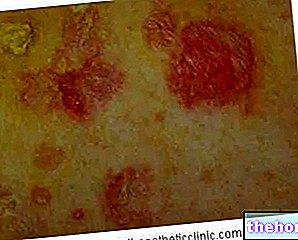Definition
Photosensitivity is an abnormal and exaggerated reaction of the skin, which becomes particularly sensitive to damage induced by sun exposure; thus a photodermatosis occurs - or a "skin rash characterized by erythema (redness), itching and burns - even after slight exposure to sunrays.
Individual sensitivity to ultraviolet radiation depends on several factors: genetic predisposition, metabolic disorders and abnormalities in pigmentation or DNA repair mechanisms.
Photodermatoses can be classified into four groups, based on their etiology:
- Idiopathic photodermatoses: polymorphic light rash, chronic actinic dermatitis, solar urticaria and actinic prurigo;
- Genetic photodermatoses: cutaneous porphyrias, Bloom's syndrome and systemic lupus erythematosus;
- Metabolic photodermatosis: porphyrias and pellagra;
- Exogenous photodermatosis: drug-induced photosensitivity and phytophotodermatosis.

Generally, photodermatosis can be the result of two different mechanisms of action:
- phototoxicity reaction: phototoxic reactions (most common) tend to occur a few hours after exposure to the sun; the inflammatory reaction that characterizes them is independent from the intervention of the immune system
- photoallergy: photoallergic reactions occur within 24-72 hours and are mediated by the immune system
Often, patients do not associate skin rash with recent sun exposure, in fact some very sensitive people can also react to winter sun, filtered and artificial light with wavelengths in the 280-400 nm range.
Differences between phototoxic and photoallergic reaction
- Phototoxic reactions. In phototoxic reactions, solar radiation reacts with the drug or with other substances deriving from its metabolism, altering its structure. These chemicals are irritating and toxic to cell membranes or DNA, and directly produce an inflammatory response on the skin (non-immune reaction) amplified by the solar reaction. The result is acute (rapid onset) and is made evident by the appearance of red or hyperpigmented spots and, sometimes, small blisters. The clinical appearance is similar to an exaggerated sunburn. Ultraviolet radiation (UVA) is most commonly associated with phototoxicity, but UVB rays and visible light can also contribute to this reaction. Phototoxic skin rash is mainly confined to the sun exposed area of the skin. Typically a phototoxic reaction resolves spontaneously once the drug is stopped.
- Photoallergic reactions. In photoallergic reactions, exposure to ultraviolet radiation acts by modifying the structure of the drug, which is recognized by the immune system as an invader (antigen). An allergic reaction is therefore induced (cell-mediated immunological response), which occurs with inflammation of the skin in areas exposed to light (dermatitis). These skin diseases have the characteristics of urticaria, with redness, peeling, and sometimes blisters and spots. Photoallergy occurs 24-72 hours after exposure to the sun and generally has a chronic (long-lasting) course. Many chemicals capable of causing photoallergic reactions require their topical application, such as aftershave lotions, sunscreens and sulfonamides. This type of photosensitivity can recur after sun exposure, even after you have finished taking the drug, and it can sometimes spread to skin surface areas that have not been directly exposed to the sun.
What is ultraviolet light?
Ultraviolet (UV) light is the radiation energy emitted by the sun in the form of invisible light waves. Only UVA and UVB radiation can reach the earth's soil.Patients may be sensitive to one type of sunlight (i.e. only UVB, UVA, or visible light) or to a wider range of radiation. The most common photosensitivity is that which occurs due to UVA rays. Tanning lamps also produce UVA and / or UVB. These artificial rays affect the skin in the same way as the corresponding natural solar radiation.
Symptoms
The skin's abnormal response to sun exposure may include the development of a rash, the aggravation of an existing rash, exaggerated sunburn, or symptoms such as itching, numbness (tingling) or burning. Disorders usually occur in the areas. exposed to the sun, including the face, neck, hands, forearms and the area under the chin.









.jpg)


















